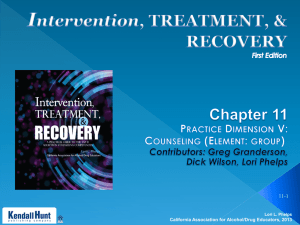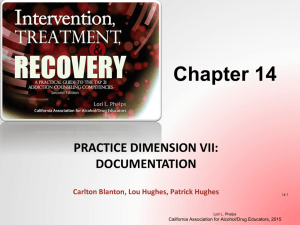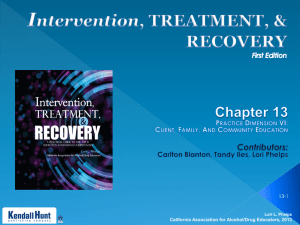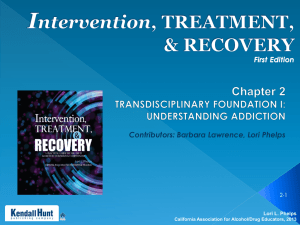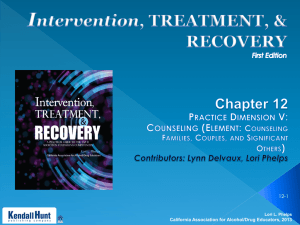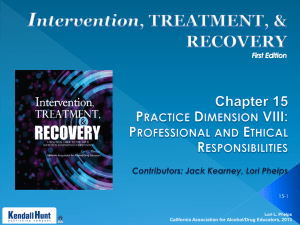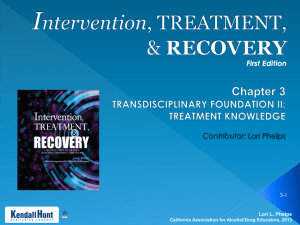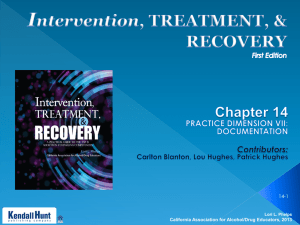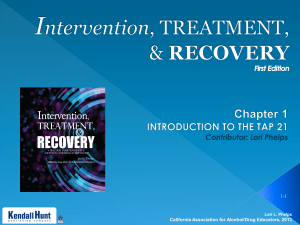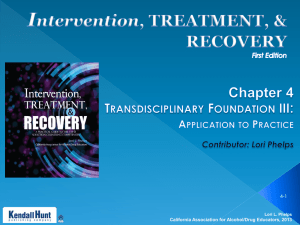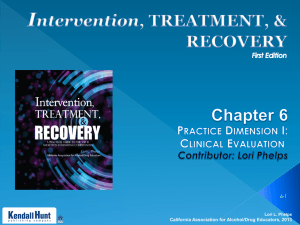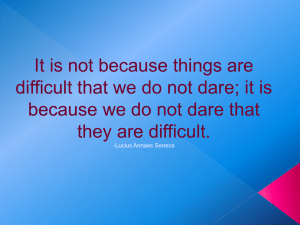Chapter 7 pptx - California Association for Alcohol/Drug Educators
advertisement
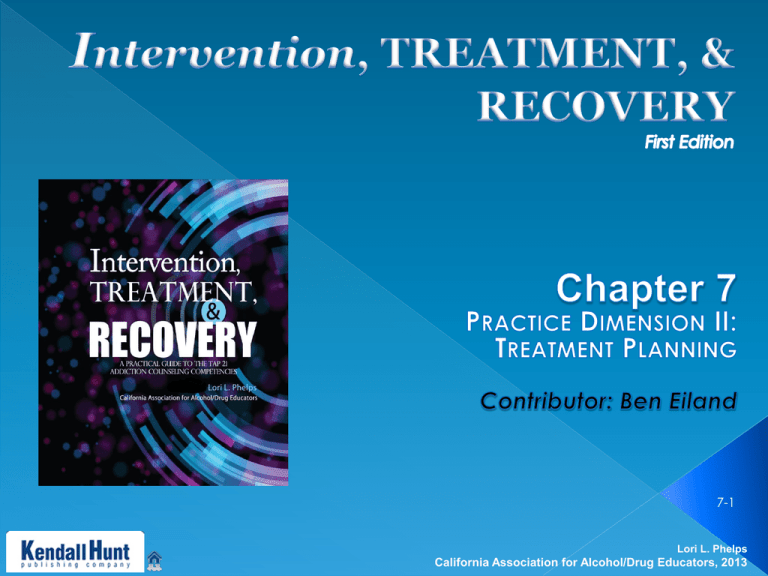
7-1 Lori L. Phelps California Association for Alcohol/Drug Educators, 2013 Competency 37: › Use relevant assessment information to guide the treatment planning process. Competency 38: › Explain assessment findings to the client and significant others. Competency 39: › Provide the client and significant others with clarification and additional information as needed. 7-2 Lori L. Phelps California Association for Alcohol/Drug Educators, 2013 Competency 40: › Examine treatment options in collaboration with the client and significant others. Competency 41: › Consider the readiness of the client and significant others to participate in treatment. Competency 42: › Prioritize the client’s needs in the order they will be addressed in treatment. 7-3 Lori L. Phelps California Association for Alcohol/Drug Educators, 2013 Competency 43: › Formulate mutually agreed-on and measurable treatment goals and objectives. Competency 44: › Identify appropriate strategies for each treatment goal. Competency 45: › Coordinate treatment activities and community resources in a manner consistent with the client’s diagnosis and existing placement criteria. 7-4 Lori L. Phelps California Association for Alcohol/Drug Educators, 2013 Competency 46: › Develop with the client a mutually acceptable treatment plan and method for monitoring and evaluating progress. Competency 47: › Inform the client of confidentiality rights, program procedures that safeguard them, and the exceptions imposed by regulations. Competency 48: › Reassess the treatment plan at regular intervals or when indicated by changing circumstances. 7-5 Lori L. Phelps California Association for Alcohol/Drug Educators, 2013 A collaborative process in which professionals and the client develop a written document that identifies important treatment goals; describes measurable, time-sensitive action steps toward achieving those goals with expected outcomes; and reflects a verbal agreement between a counselor and client. › (CSAT, 2006a, p. 55) 7-6 Lori L. Phelps California Association for Alcohol/Drug Educators, 2013 Includes: › the identified substance use disorder(s) › issues related to treatment progress including Relationships with family and significant others Potential mental conditions Employment Education Spirituality Health concerns Social and legal needs. 7-7 Lori L. Phelps California Association for Alcohol/Drug Educators, 2013 Treatment planning depends on screening and assessment Screening › CAGE, MAST, DAST, SASSI, SBIRT Assessment › Addiction Severity Index Screening and assessment should engage the client, identify key collaterals (with contact information), identify strengths 7-8 Lori L. Phelps California Association for Alcohol/Drug Educators, 2013 Determine these key factors: › severity of mental and substance use disorders; › the appropriate care setting (e.g., inpatient, › › › › › outpatient, day-treatment); an appropriate diagnosis; the level of disability and functional impairment; readiness for change; cultural and linguistic needs and supports; additional problem areas(e.g., physical health, housing, vocational, educational, social, spiritual, cognitive, etc.). 7-9 Lori L. Phelps California Association for Alcohol/Drug Educators, 2013 Determine the extent and severity of the AOD abuse problem; Determine the level of maturity and readiness for treatment; Ascertain concomitant problems such as mental illness; Determine the type of intervention necessary to address the problems; Evaluate the resources available to help solve the problem. Typical resources include family support, social support, educational and vocational attainment, and personal qualities such as motivation that the client brings to treatment; Engage the client in the treatment process. 7-10 Lori L. Phelps California Association for Alcohol/Drug Educators, 2013 Biopsychosocial Continuum of care: interlinked treatment modalities and services; individuals’ changing needs will be met as they move through the treatment and recovery process. Dual Diagnosis (Co-Occurring Disorders) Eligibility criteria: financial status, insurance coverage, age, severity of illness, geographic location, special needs Intensity of Service Level of care (ASAM) 7-11 Lori L. Phelps California Association for Alcohol/Drug Educators, 2013 Medically monitored detox Social model detox Day treatment Intensive outpatient programs (IOP, usually 9–12 hours weekly) Outpatient program (usually 3–6 hours weekly) Medical model treatment (usually 28 days) Residential treatment: Therapeutic community (TC); Social model treatment (usually 12-step based) 7-12 Lori L. Phelps California Association for Alcohol/Drug Educators, 2013 Precontemplation Not thinking about change May be resigned Feeling of no control Denial: does not believe it applies to self Believes consequences are not serious Contemplation Weighing benefits and costs of behavior, proposed change Preparation Experimenting with small changes Action Taking a definitive action to change Maintenance Maintaining new behavior over time Relapse Experiencing normal part of process of change Usually feels demoralized 7-13 Lori L. Phelps California Association for Alcohol/Drug Educators, 2013 7-14 Lori L. Phelps California Association for Alcohol/Drug Educators, 2013 Measurable—Objectives are measurable so that the client and counselor can document change. Attainable—Goals, objectives, and interventions should be achievable in the active treatment phase. Time-Limited—Focus on time-limited or short-term goals and objectives Realistic—Client can realistically complete objectives within specific time period Specific—Objectives and interventions are specific and goal-focused 7-15 Lori L. Phelps California Association for Alcohol/Drug Educators, 2013 Project Cork (MAST, DAST, CAGE, ASI) http://www.projectcork.org/clinical_tool s/index.html Treatment Planning M.A.T.R.S.: Utilizing the Addiction Severity Index (ASI) to Make Required Data Collection Useful http://www.attcnetwork.org/explore/priorityareas/ science/blendinginitiative/txplanningmatrs/ 7-16 Lori L. Phelps California Association for Alcohol/Drug Educators, 2013
